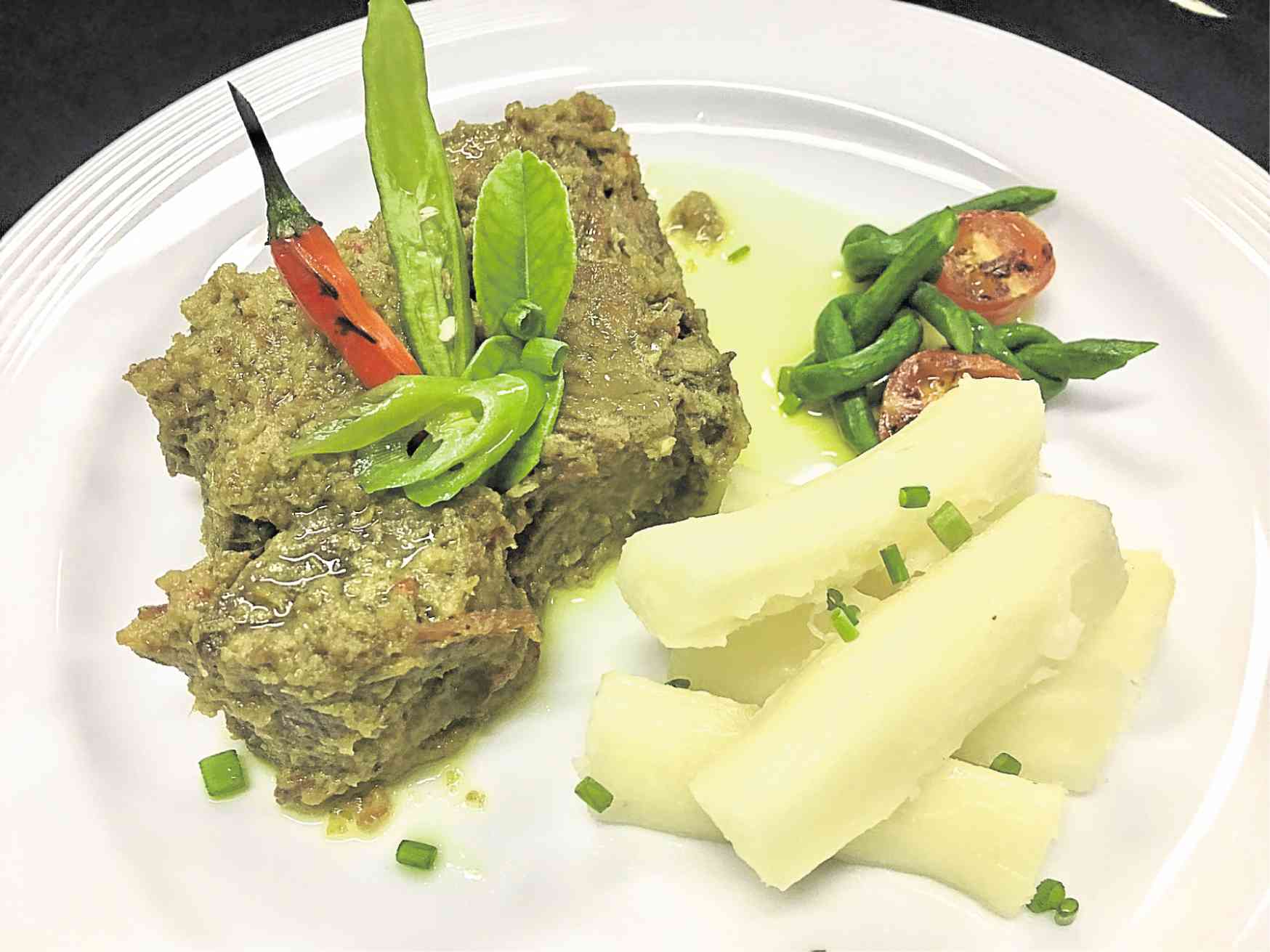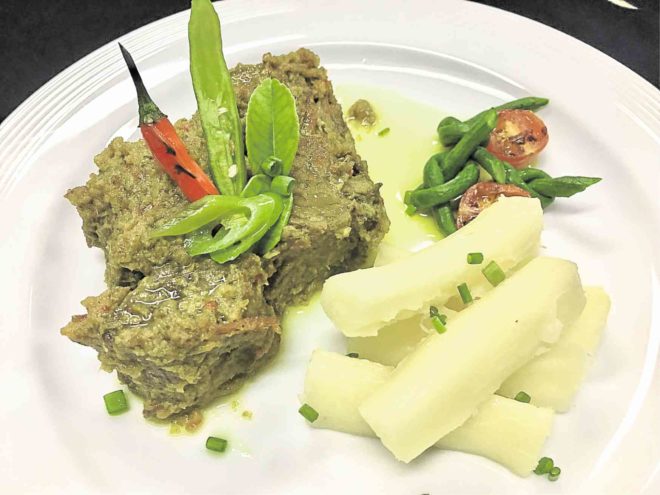
Indonesia’s beef ‘rendang’ by Glenda Barretto
Her take is similar to Malay-Indonesian rendang in its use of the same spices and herbs. However, unlike the original Indonesian dish that’s extremely hot and spicy, chef Glenda Barretto’s version is toned down for the Filipino palate. Instead of using dried chilli, she utilizes seeded finger chili (siling sigang) to add some nice kick to the bite.
Instead of adding refined sugar to balance the overall taste, she uses panocha to cut the richness of the coconut sauce and make it taste fresh and flavorful.
Barretto, the doyenne of Philippine cuisine, pairs the dish with cassava (kamoteng kahoy) cooked in coconut milk.
“Kamoteng kahoy is not very popular, but it’s really delicious and healthy,” said Barretto, who buys from organic farmers.

Beef ‘rendang’
1 k beef brisket, cut into
1 ½-inch cubes
2 c coconut milk
½ c coconut cream, first extraction
50 g panocha (raw cane sugar) dissolved in ¼ c coconut milk
Sea salt to taste
6 pieces Kaffir lime leaves, rolled and sliced into chiffonade
1 piece turmeric leaf, knotted
Spice paste:
2 tbsp vegetable oil
6 cloves garlic, chopped
3 tbsp ginger, chopped
3 tbsp galangal, chopped (or 1 tsp galangal powder)
3 tbsp turmeric, chopped
3 pieces lemongrass (white part only), chopped
6 pieces shallots
6 pieces bird’s eye chili
3 pieces finger chilli, seeded
To make the spice paste: Put all the above ingredients in a food processor and process until fine. Heat oil in a pot and fry the paste for about 10 minutes or until fragrant. Add the Kaffir lime leaves and turmeric leaf. Add beef cubes to the fried spice paste. Stir in coconut milk and add salt to taste.
Bring to a simmer, cover and stir from time to time until beef is tender (about four hours). Add panucha, increase the heat and cook a few minutes until sauce has thickened. Add coconut cream, simmer for a further 10 minutes.
Serve with steamed rice.
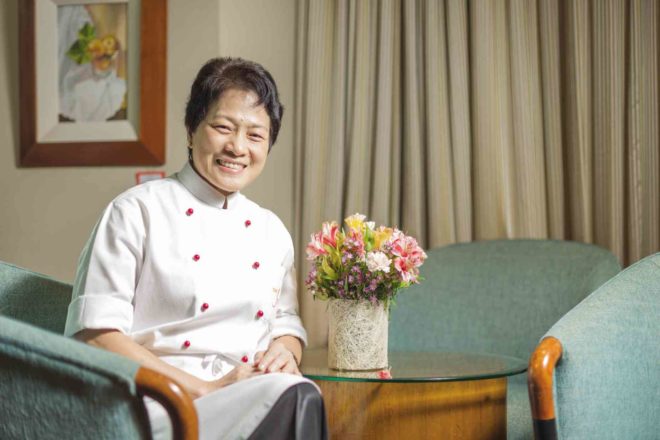
Malaysia’s ‘kueh dadar’ by Jessie Sincioco
Kueh dadar is a typical Malaysian dessert presented in rolled pandan crepe heaving with grated coconut meat cooked in gula Melaka (palm sugar). Chef Jessie Sincioco first tried the dish in Singapore when she had a brief culinary training at The Pavilion Hotel. “It was love at first bite because the taste was so familiar,” she said. “It made me remember the bukayo (sweetened coconut meat) that my mother used to make for us in Bulacan.”
Sincioco cooks the sweet filling carefully until she achieves the “bukayo-like” texture of the coconut meat. She likes the idea of wrapping the sweetened coconut in pandan-flavored crepe. “It’s simple but delectable. I could finish 10 rolls in one sitting with a hot cup of coffee,” she said.
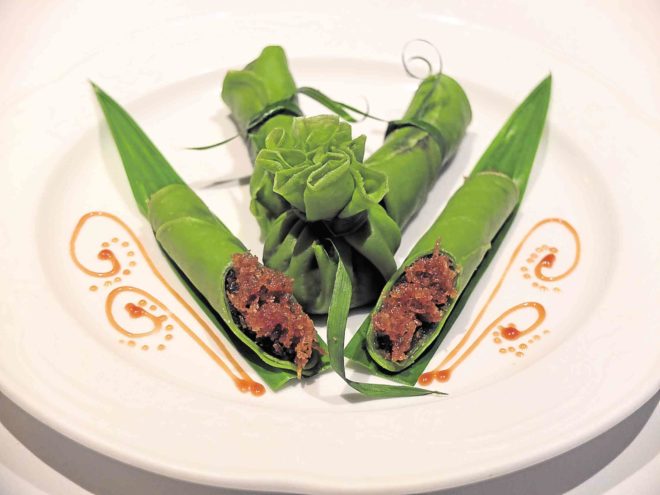
‘Kueh dadar’ Crepe:
50 g cake flour
5 g sugar
1 whole egg
20 g melted butter
100 ml fresh coconut milk
5 pandan leaves
pinch of salt
Filling:
50 g freshly grated white coconut meat
100 g gula Melaka, cut into small pieces
50 ml water
2 pandan leaves
To make the crepe, mix together flour and sugar in a stainless mixing bowl. Make a well in the center and add egg and butter. Using a blender, puree coconut milk and pandan. Sift pureed pandan and coconut milk unto the flour mixture. Stir with a wire whisk until mixture is smooth. Add salt.
Heat a 6-inch Teflon pan and brush slightly with butter. Fill bottom part of the pan with a very thin coating of the crepe mixture. Flip pan to cook the other side of the crepe. Transfer cooked crepes on a tray.
To make the filling, combine grated coconut meat, gula Melaka, water and pandan leaves in a pot. Cook and stir continuously until water dries up.
To assemble, lay one crepe on a plate and fill the center with about two tablespoons of the coconut filling. Wrap filling by folding both sides of the crepe and roll into an inch-round tube.
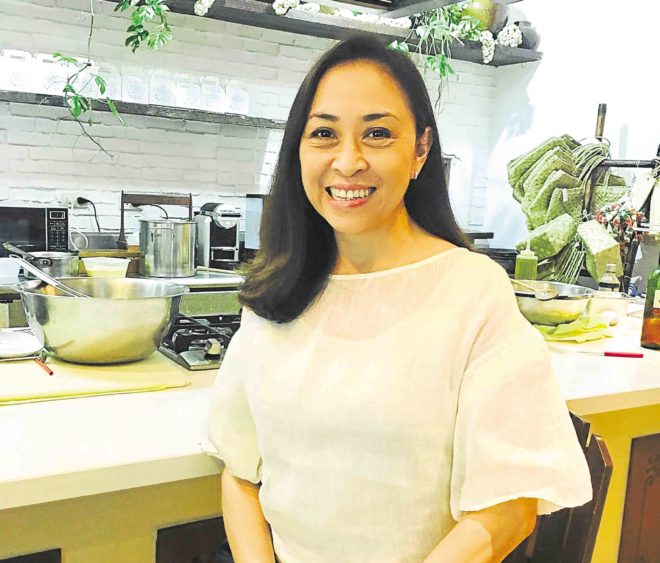
Vietnam’s ‘bánh mì’ by Heny Sison
Vietnamese bánh mì has been dubbed one of the most delicious sandwiches in the world. Chef Heny Sison learned how to bake baguette the authentic way from a local baker in Vietnam.
“They add ascorbic acid into their French bread,” said Sison. “It helps relax the dough, making it lighter and crispier. When you bite into it, it’s like eating croissant in Paris. It crumbles in your mouth.”
Instead of using liver or chicken pâté as filling, Sison’s bánh mì highlights the goodness of a Filipino favorite dish, embutido. She puts slices of embutido on one side of the bread and brushes them lightly with mayonnaise and softened butter. She adds slivered singkamas (turnip), cucumber, carrots and wansoy to give the sandwich its characteristic textural crunch.
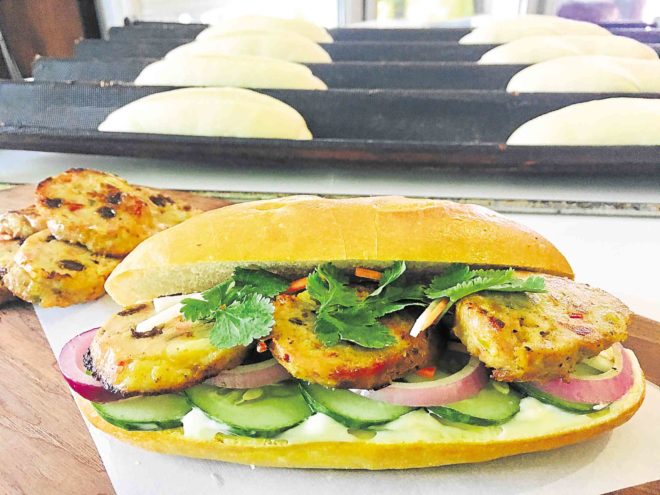
‘Bánh mì’
3.75 k all-purpose flour
15 g dough improver
1 tbsp salt
150 g water
5 tbsp sugar
40 g yeast
1 capsule ascorbic acid (remove the cover)
Mix all ingredients at low speed of the mixer until blended. Switch speed to high and knead until smooth and pliable. Divide dough into 120 g pieces. Bench proof for 15 minutes. Shape and roll into a baston. Put in the pan. Proof for 1 ½ hours in the proofer or 2 hours at room temperature (without plastic cover).
Score. Spray with water. Bake at 350°F for 15 minutes or until golden on top. Transfer on wire racks to cool.
‘Bánh mì’ sandwich
Vietnamese baguette
Magnolia Gold Butter, softened
Mayonnaise
Cucumber slices
Embutido, sliced and pan-fried
Pickled carrots and singkamas
Wansuy
To assemble: Slice bread in half. Brush with softened butter. Toast in the oven until slightly crispy. Spread mayonnaise on the other half of the bread. Arrange cucumber slices, pickled carrots and singkamas. Top with the pan-fried embutido and wansuy.
Philippines’ chocolate ‘biko’ by Dorothy Ferreria
Biko is a sweet rice cake usually made from sticky rice (malagkit), coconut milk and sugar. Pandan leaves (aka screw pine leaves) would sometimes be added to make it more aromatic, or ginger or anise for subtle spiciness. But chef Dorothy Ferreria’s version has cocoa to make it more appealing to a larger crowd.
“It is like having champorado (chocolate rice porridge) in solid form,” she said.
For those with adventurous palates, Ferreria recommends adding 2 to 3 pieces of chopped bird’s eye chili to provide a certain degree of palate-tickling heat.
Ferreria’s chocolate biko reflects the creativity and adventurous nature of the Filipino cook.

Chocolate ‘biko’
2 c raw short grain rice (pure malagkit)
2 coconuts, grated
2 c warm water
½ c and 1 tbsp sifted cocoa
3 tbsp butter
¾ c white sugar
Wash rice three times until water runs clear. Transfer to a big mixing bowl. Add enough water to cover rice. Let stand for 1 hour.
Add 2 c warm water to the grated coconut, mix well and squeeze out the coconut milk. Measure milk in a glass measuring cup. It should total 3 ½ c. If the yield is less than this amount, add an adequate amount of water to the coconut milk. Discard the grated coconut.
After one hour of soaking, drain the rice in a colander. Transfer to a large wok and add 3 ½ c of coconut milk, cocoa and butter. Place over medium heat and allow to boil. Continue to cook with constant stirring until almost dry. Add the sugar and continue to cook until very thick. Transfer to a tray previously greased with butter.
Thailand’s sticky rice with fresh fruits by Dorothy Ferreria
This popular Thai dessert usually features ripe mangoes and rice, or durian and rice. Ferreria enjoys this dessert because it is similar to our suman served with ripe mangoes, but at the same time it is refreshingly different because of the creamy white sauce.
To make it more interesting, she adds a sprinkling of toasted sesame seeds with sugar, similar to the dipping sauce for another rice cake called palitaw.
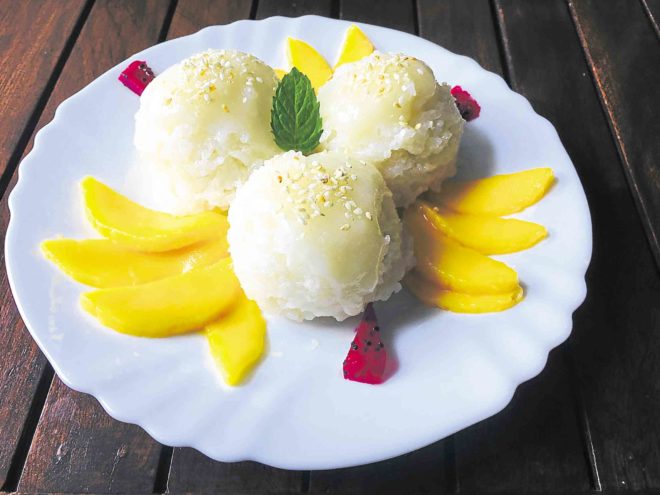
Sticky rice with fresh fruits
2 c raw short grain rice (pure malagkit)
2 c water to cook rice
Sauce:
200 g coconut powder
1 c warm water
1 c white sugar
½ tsp fine salt
Topping:
2 tbsp sesame seeds
1 c white sugar
Assorted sliced fresh fruits, such as ripe mango, ripe papaya, dragon fruit or kiwi
Wash rice three times or until clear. Combine rice and water into a rice cooker. Cover and cook until done.
To prepare the sauce, dissolve coconut powder in warm water. Transfer to a saucepan and pour in sugar and salt. Cook over low heat, stirring continuously, until slightly thick.
When ready to serve, form cooked rice into mounds using a small tea cup as molder. As an alternative, use an ice cream scooper to form rice into mounds. Arrange rice in a serving platter and surround with preferred fresh fruits. Drizzle the prepared sauce over the rice. Top with sesame seed sugar mixture.
To prepare topping, toast sesame seeds in a frying pan until light golden brown. Pound into a powder using a mortar and pestle. Transfer to a small bowl and add sugar. Mix well.

